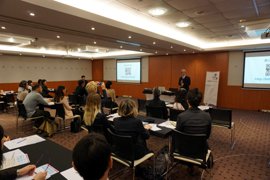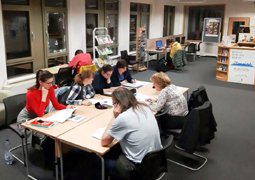JFBP that Supports Diverse Japanese-Language Education
The Japan Foundation, Budapest
HAYASHI Toshio/OMURO Fumi
At the Japan Foundation, Budapest (hereinafter “JFBP”), we support Japanese-language education in Hungary, where we are located, and in twelve other countries in Central and Eastern Europe (Poland, Romania, Bulgaria, the Czech Republic, Serbia, Slovakia, Slovenia, Croatia, Bosnia and Herzegovina, Montenegro, North Macedonia, and Kosovo), while running a Japanese-language course at the JFBP. In this report, Hayashi, who is responsible for the whole region of Central and Eastern Europe, and Omuro, who is in charge of Hungary itself, introduce their work.
Aiming for Exchanges with Japanese Teachers
When it comes to wide-area support for the whole of the Central and Eastern European region, there are a lot of official visits. In 2018 I visited Romania in September and Bosnia and Herzegovina in October; in 2019 I went to Serbia and Poland in March, Bulgaria in April, and North Macedonia in May. I also attended the “The 2018 International Conference on Japanese Language Education-Venezia” (Venezia 2018 ICJLE), where I interacted with Japanese teachers who gathered from around the world; I reconsidered the challenges of Central and Eastern Europe, and was able to gain many hints about how to support the wide Central and Eastern European region, including a plan for the Japanese-Language Education Network in Central and Eastern Europe, which I will talk about below. In Bosnia and Herzegovina and North Macedonia, where there are very few Japanese teachers, several different trials are taking place thanks to the efforts of these teachers and their learners, and I was very surprised when I was able to confirm that the learners’ Japanese language skills really are increasing steadily. Meanwhile, in Bulgaria, I inspected a large school (the school has a total of 2,400 students, 600 of whom are Japanese-language learners) that offers Japanese-language education with a formal curriculum from the primary education level—I was greatly impressed by the young primary school students, who enjoy learning Japanese through song, shiritori, Japanese word-chain games, and other types of game.
Heading to local areas like this and observing the current situation is extremely important, but due to timing and costs, I don’t often get to visit lots of different areas. Consequently, as a new experiment, I am exploring a way of connecting to workshop events via the Internet and participating virtually. To date, I have participated in workshops held in Bulgaria and the south of Poland in this way, but have found that there are technical challenges: the line would be unstable, and we would get howling feedback if multiple computers and smartphones are used. On the other hand, we tried connecting to Croatia and carrying out an experiment in which members of the Association of Japanese Language Teachers in Croatia gathered in a classroom and participated in a workshop together, with online training streamed from the JFBP. Non-native Japanese-speaking teachers who felt there were fairly high hurdles to participating individually online seem to have found it easier to participate using this method.
The Japanese-Language Education Network in Central and Eastern Europe 2019

The Japanese-Language Education Network in Central and Eastern Europe 2019
The Japanese-Language Education Network in Central and Eastern Europe (hereinafter “Network”) serves as a once-a-year opportunity for the assembly of teachers involved with Japanese-language education in the diverse environment of Central and Eastern Europe. This Network was held in Budapest on February 23 and 24, 2019, and 60 participants from a total of 14 countries, including the hosts, met under one roof. It was attended by 11 of the 13 countries mentioned above that are supported by the JFBP (the exceptions were Montenegro, which canceled its attendance on short notice, and Kosovo, which is not acknowledged to offer Japanese-language education), as well as participants from Ukraine, Belarus, and Japan.
The overall theme for 2019 was “Perspectives and tricks for improving class lessons”; we invited professor YOKOMIZO Shinichiro (Seinan Jo Gakuin University) from Japan, who specializes in the development and training of foreign language teachers and considers the specific role of teachers in the classroom, to give a keynote speech and a workshop, and the participants focused on considering the issue of perspectives and tricks for improving their class lessons via participant presentations and group discussions.
We also created an official website for the Network, as we did for the 2018 Network, and formed an online community before the Network event. As it was pointed out that the number of emails that participants used for the mailing list up to last year had grown, this year we also introduced a new Slack. We did hear that some people weren’t familiar with parts of this, but it was generally well-received, as we were able to create channels for each section, such as “self-introductions” and “book recommendations.” We also created a padlet so that participants could casually post comments on the day of the Network. The Network has gradually evolved using these tools, and I believe that participants were able to use the group discussions that took place in the physical location to deepen their bonds with each other and share their awareness of issues and their concerns. (Hayashi)
The Changing Japanese-Language Course
In Hungary, the environment surrounding Japanese-language learning changes each year, as it does in other countries. DEKIRU 1, a Japanese-language textbook based on the CEFR standards, was published in 2011, and DEKIRU 2 was issued in 2012, and both are now in widespread use. Plus, nowadays I meet a number of learners who are studying Japanese independently through online resources. The JFBP’s Japanese-language course has also changed, little-by-little, with the needs of our learners and the times. At the moment, we are running five courses: the Comprehensive Course, which uses the abovementioned DEKIRU 1 and 2 and Marugoto Intermediate 2(B1); the Topic Course, through which learners study a variety of topics; the Autonomous Learning Course, through which learners make plans to progress by themselves, with the support of a teacher; the e-learning Course, which uses JF Japanese e-learning Minato; and the Cultural Japanese Course, through which learners can enjoy studying Japanese culture regardless of their Japanese-language level.

The Autonomous Learning Course
The e-learning Course is a new course that began in September 2018. Participants self-study via online content, and attend a live lesson once every two weeks. At the moment, there are very few Japanese-language educational institutions in cities other than Budapest, and so the fact that we can offer people the chance to learn Japanese, regardless of where they live, is a huge step forward. The Autonomous Learning Course has participants from a variety of backgrounds, including people who have finished the Comprehensive Course, people who had been studying by themselves but wanted the support of a teacher, and people who attend because they want to be able to speak a little Japanese before a trip to Japan. In classes, participants independently form groups and study together, and we have observed senior Japanese-language learners offering advice to their juniors. I cannot help but feel the greatness of the study abilities of learners, and of community, through these courses.
What is the role of teachers and classrooms? It involves ongoing trial-and-error, but the JFBP also values the fostering of autonomous learners in other courses, and is working each day on activities that make good use of the strengths of the community of the classroom. (Omuro)
- What We Do Top
- Arts and Cultural Exchange [Culture]
- Japanese-Language Education Overseas [Language]
- Japanese-Language Education Overseas [Language] Top
- Learn Japanese-language
- Teach Japanese-language
- Take Japanese-Language Test
- Know about Japanese-language education abroad
- The Japanese-Language Institute, Urawa
- The Japanese-Language Institute, Kansai
- Japanese-Language Programs for Foreign Specified Skilled Worker Candidates
- Japanese Language Education for Japanese Children Resident Overseas and for the Descendants of Migrants
- Archives
- Japanese Studies and Global Partnerships [Dialogue]
- JF digital collection
- Other Programs / Programs to Commemorate Exchange Year
- Awards and Prizes
- Publications
